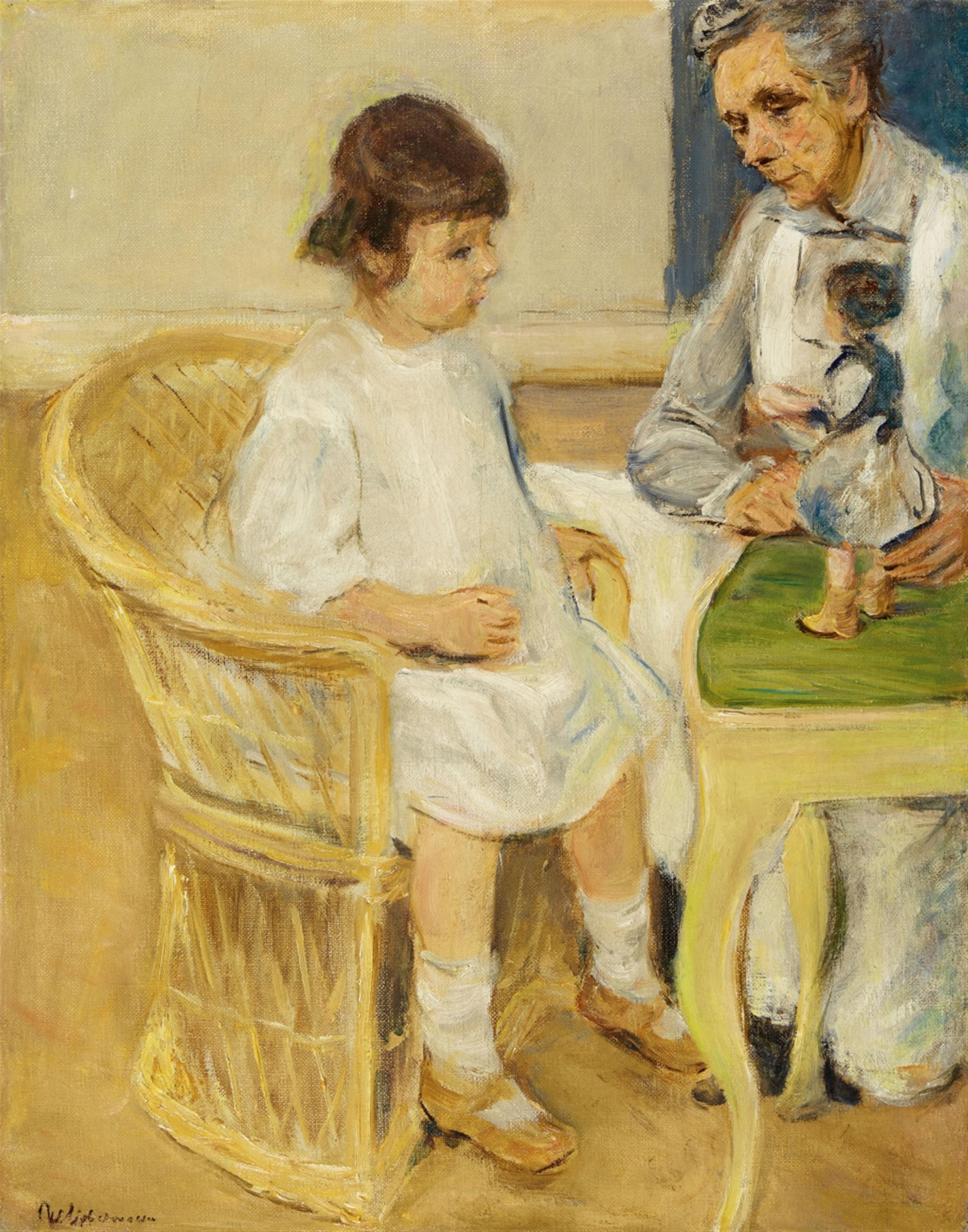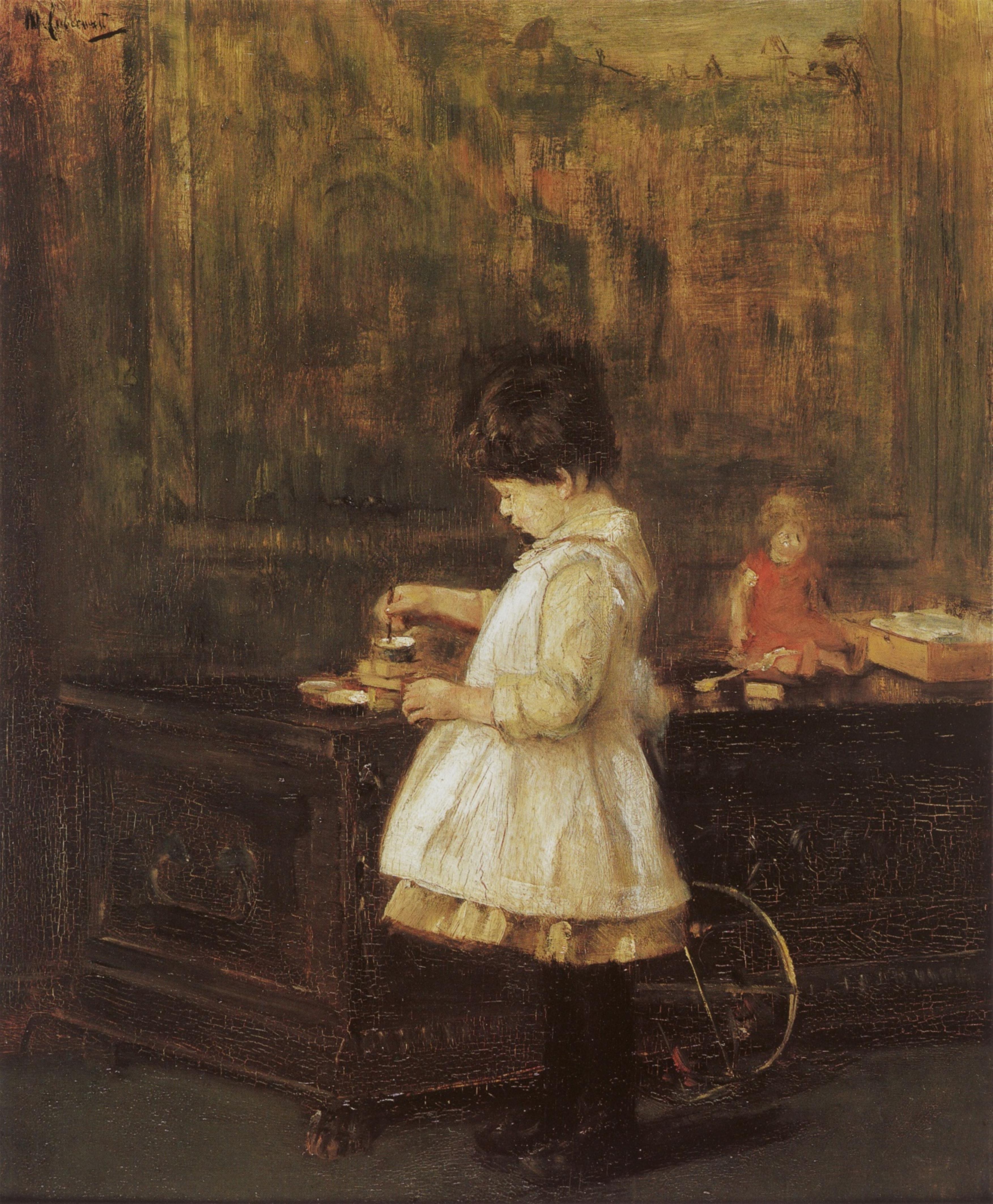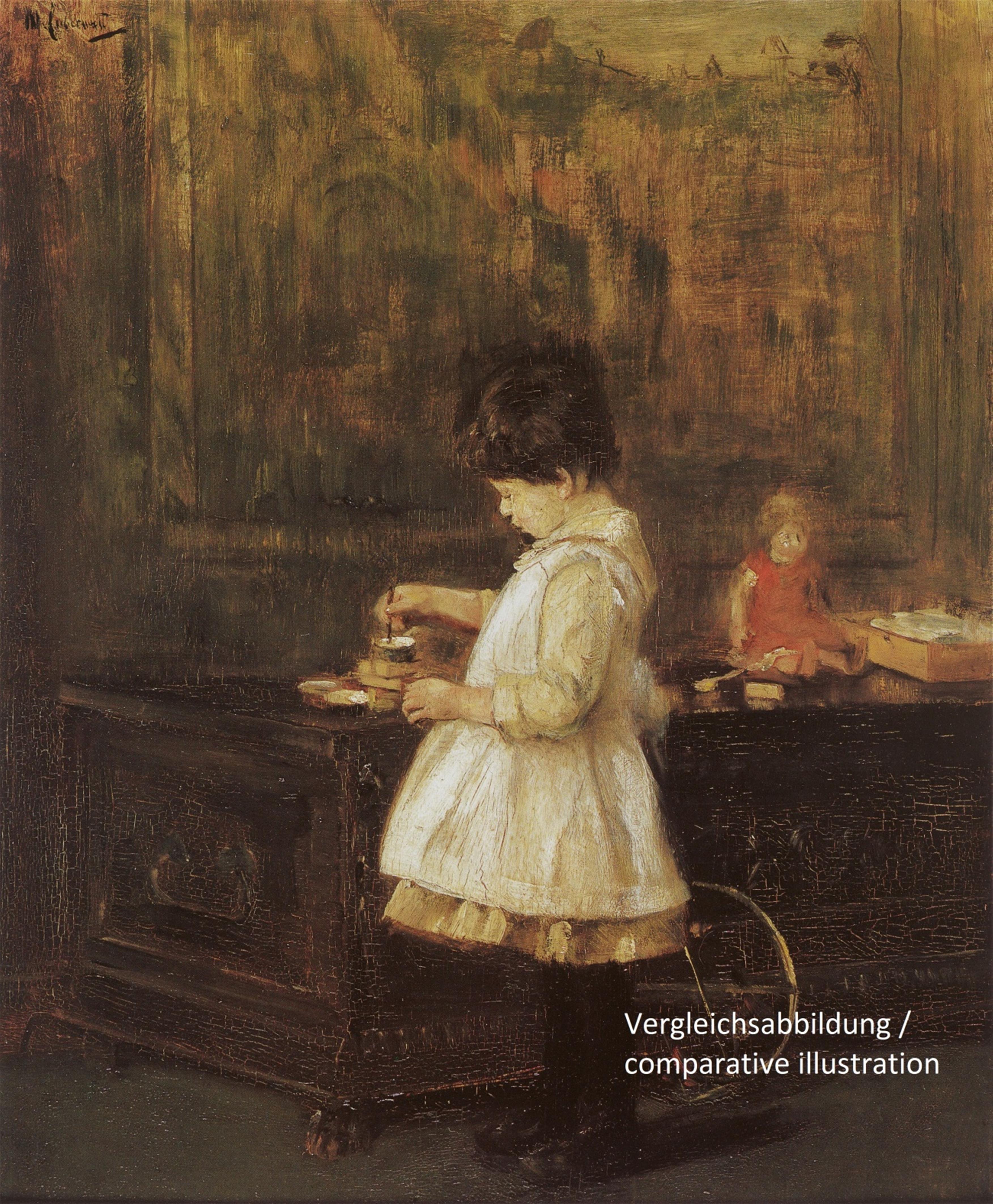Max Liebermann
Die Enkelin im Korbsessel nach rechts
1920
Oil on canvas 52 x 40.5 cm Framed. Black estate stamp "M. Liebermann" lower left (Lugt 4763, fragmented). - Fine craquelure in the pastose areas, overall in fine condition.
After showing works by Max Slevogt at the beginning of 1923, Munich's “Moderne Galerie Thannhauser” presented a widely noted monographic exhibition of Max Liebermann's paintings and works on paper, which was arranged by the artist himself. Among these, there were more recent portraits (“Heinrich Thannhauser”, 1919; “Albert Einstein”, 1922) and likenesses of members of his own family, particularly portraits of the artist's little granddaughter - such as the present work, which was presented publicly for the first time to the audience in Munich under the title “Kind mit Wärterin” or, alternatively, “Kind mit Wärterin und Puppe”. Karl Scheffler, art critic and avowed champion of German Impressionism, praised the almost “symbolic” quality of this survey show, and he emphasised the colouristic brightness of a “light, transfigured late style” in these depictions of children by Max Liebermann, adding: “Something hovers within the painting, a tenderness extending across a distance, like that which is natural to old age” (cited from Kunst und Künstler, 1923, op. cit., p. 241). Erich Hancke also observed a “fine, affectionate understanding of humanity” in this fresh group of works featuring Maria, Liebermann's granddaughter - particularly since the summer of 1919 - and Hancke perceived its not just thematically, but also qualitatively, remarkable equivalence with the artist's early images of Käthe Liebermann: “These pictures can be placed without hesitation alongside the wonderfully intimate portraits that Liebermann had painted of his little daughter years before” (Erich Hancke, Max Liebermann, 1923, op. cit., p. 514).
If the images of the girls- mother and daughter, each at around three years old - are placed alongside one another (compare the present picture featuring the motif of the doll with “Die Tochter des Künstlers, spielend”, 1888, see comparative ill.), they demonstrate Liebermann's mastery through the characterisation of each as well as the density of Liebermann's observations. Beyond this, the two images' distinctive artistic finesse also links them across the decades and in spite of a clear change in style. This additionally renders the comparison across his expansive oeuvre particularly fascinating. The exhibition at Thannhauser's gallery had already permitted a direct comparison in 1923.
Liebermann's composition of 1920 is striking in its interlocking of the depicted figures with the geometricised backgrounds, which are accentuated as monochrome fields of colour and, serving as tone-in-tone foils, consolidate and calm the freely developed and vibrant motif of the foreground. Whereas Maria is captured in a very painterly manner, surrounded by the curve of the wicker chair in her light little dress in front of the puffy white of the kneeling minder's skirt, the old woman - whose head is developed in the manner of a portrait and who holds the thin-limbed doll in her hands - is made the subject of special attention through the more precise and chromatically delicate formulation of details. Liebermann enjoys playfully suggesting our having placed ourselves on the level of the child and sharing in her absolute concentration, amazement and fascination and in the magic of the moment.
On the one hand, the artistically nuanced formal elements of the picture's composition reaffirm the naturalness and simplicity of the picture's subject; on the other hand, they provide a revealing testament to the changed times and the altered circumstances of Liebermann's life. In the very first years of her life, Maria Riezler (27 March 1917, Berlin - 14 January 1995, New York) often stayed at her grandparents' home next to the Wannsee. As a senior civil servant in the foreign ministry, a diplomat and, in 1919/1920, a close associate of President Friedrich Ebert, Dr Kurt Riezler was obligated to fulfil political as well as diplomatic duties; he and his wife repeatedly went on journeys together, and in Liebermann's paintings the little girl is thus usually entirely realistically accompanied by the older “Bonne”, her nanny Ida Schönherr. Max Liebermann casually and very discreetly succeeds in depicting the obviously large generational gap, but also the necessary and everyday companionship between the two.
This finds a comparably appealing expression in the larger painting “Enkelin und Kinderfrau auf der Gartenbank” (Eberle 1919/32), from 1919, where minder and child sit together studying a picture book - a work by Max Liebermann that a private donor had already given to the Berliner Nationalgalerie in 1919 and which was part of the museum's collection until 1933, but whose whereabouts have remained unknown since that time.
Catalogue Raisonné
Eberle 1920/30
Certificate
Assisted by Lempertz, a fair restitution agreement could be achieved between the heirs of Max Liebermann und the current owners in 2020.
Provenance
Collection Max and Martha Liebermann, Berlin (until 1935); Dr. Conrad Doebbeke, Berlin; Kunsthandlung Carl Nicolai, Bad Kohlgrub (1950s, stamp verso, barely legible), Lempertz, Cologne, 451. Auktion, 28 October 1958, Lot 176; Stuttgarter Kunstkabinett Ketterer, 33. Auktion, 29/30 May 1959, Lot 511; Private possession, Germany; Collection Georg Schäfer, Schweinfurt (frame label verso); Christie's London, German and Austrian Art II, 17 October 2000, Lot 42; Private collection, Berlin
Literature
Erich Hancke, Max Liebermanns Kunst seit 1914, in: Kunst und Künstler, vol. XX, issue 10, June 1922, p. 340-355 with ill. p. 345; Willy Kurth, Der Spätstil Max Liebermanns, in: Die Kunst, vol. XXXVII, issue 45, Munich 1922, p. 174 ff. with ill. p. 178; Karl Scheffler, Max Liebermann in München (Ausstellung bei Thannhauser), in: Kunst und Künstler, vol. XXI, issue 8, April 1923, p. 241; Erich Hancke, Max Liebermann, Sein Leben und seine Werke, Berlin 1923, vgl. S. 514, 520; C. Sylvie Weber (ed.), exhib. cat. Max Liebermann, Poesie des einfachen Lebens, Kunsthalle Würth, Künzelsau 2003/2004, p. 218 with full-page colour ill. p. 135
Exhibitions
Munich 1923 (Moderne Galerie Thannhauser), cat. no. 34 ("Kind mit Wärterin"); Zurich 1923 (Zürcher Kunsthaus), Max Liebermann, cat. no. 99 ("Kind mit Wärterin, L. 40 x 50,5, Max Liebermann, Berlin, 1921"); Hanover 1927 (Kunstverein), Große Kunstausstellung, cat. no. 208 with ill.; Kassel 1927 (Orangerie), Jubiläums-Kunst-Ausstellung, cat. no. 241; Schwäbisch Hall 2003/2004 (Kunsthalle Würth), Max Liebermann, Poesie des einfachen Lebens (frame label verso)






